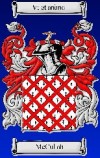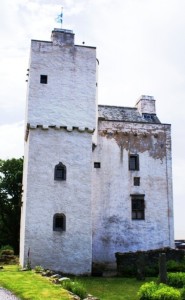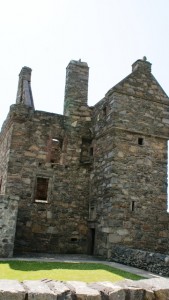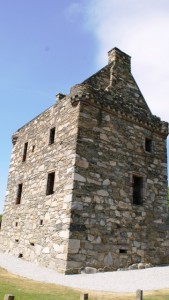Barholm Castle
Barholm Castle is a traditional Scottish tower house situated on a hillside overlooking Wigtown Bay and the Machars of Wigtownshire. It was constructed in at least two stages and consists of a rectangular tower with its earliest origins probably dating from the late 15th century and a later stair tower built on the NE side, probably late in the 16th century.
In “The Fortified House in Scotland” edited by Nigel Tranter, vol 3, the following description is given, “…this interesting tower, sometimes identified with Ellangowan in Guy Mannering. It was the seat of a branch of the powerful Galloway family of McCulloch like nearby Cardoness who acquired it in the early 16th century. John Knox is said to have used Barholm as a place of refuge previous to his flight to the continent – presumably in his early career. If so, he was here perilously near the home of that most determined of papal churchmen Abbot Gilbert Brown of Carsluith, just 2 miles away.
It is worthy of note that the religious views of the two families did lead to serious clashes, for in 1579 John Brown Younger of Carsluith was called to account for the slaughter of McCulloch of Barholm. The McCullochs were strong for the Reformation and later became equally ardent Covenanters. Major John McCulloch of Barholm was executed for his share in the Pentland Rising of 1666. “
Perhaps the greatest volume of information about the Barholm branch of the McCulloch family is present in the manuscript “A History of the Galloway Families of McCulloch” (Walter Jameson McCulloch) which is available in the Ewart Library Dumfries. However, as pointed out by W. J. McCulloch, “For reasons best known to themselves, successive representatives of the branch have firmly and repeatedly refused to allow the family documents and papers to be examined.” What is known is mainly derived from written legal records, but the lack of detailed records limit what can be said about the building, its structural changes and its occupancy. The designation “Barholm” often refers more to the branch of the family and a geographical area, rather than to a specific place.
The lands of Barholm passed (back) into the hands of the McCulloch family early in the 16th century, but a tower house was probably on the present site by late in the 15th century. A building designated Barholm Castle was clearly established on this site at the time of the survey carried out between 1584 and 1596 by Timothy Pont, and published in the 17th century Blaeu maps. While this was probably substantially the present structure, it cannot be said with certainty that the stair tower was in place at this time.
The date present on one of the quoins on the west side of the stair tower at a height of around 3m. indicates “1375”; this is inconsistent with such an L-shaped tower, but it is suggested (J. Zeune, “The Last Scottish Castles”, VML, 1992) that mediaeval masons often carved a “5” upside-down so that it appeared as a “3”, which would then indicate a date of 1575 (or 1573). Such a date for the addition of the stair tower would be consistent.
 Structural evidence suggests that the stair tower was an addition to the earlier rectangular tower, giving rise to the present L-form. The presence of an apparent filled door at a height of around 2m on the east side of the rectangular part, and the better state of the stair tower, provide structural support for this. A door at first floor level is a defensive feature characteristic of the 15th rather than 16th century. Carsluith Castle, close by, is considered to date from the early 16th century and appears only ever to have had ground level access . The fact that the stair tower is considered to date from late in the 16th century or early in the 17th century is however at odds with the story of John Knox having hidden in the arched room at the head of the staircase (the present cap house?) around 1566; the first written record of this appears to have been made over two and a half centuries later, based on an account given by the great grandson of a man who recalled John Knox’s signature being present on the wall of the room at the top of the stair tower.
Structural evidence suggests that the stair tower was an addition to the earlier rectangular tower, giving rise to the present L-form. The presence of an apparent filled door at a height of around 2m on the east side of the rectangular part, and the better state of the stair tower, provide structural support for this. A door at first floor level is a defensive feature characteristic of the 15th rather than 16th century. Carsluith Castle, close by, is considered to date from the early 16th century and appears only ever to have had ground level access . The fact that the stair tower is considered to date from late in the 16th century or early in the 17th century is however at odds with the story of John Knox having hidden in the arched room at the head of the staircase (the present cap house?) around 1566; the first written record of this appears to have been made over two and a half centuries later, based on an account given by the great grandson of a man who recalled John Knox’s signature being present on the wall of the room at the top of the stair tower.
 Barholm tower appears to have remained the seat of this branch of the McCullochs until the middle part of the 18th century. The castle then fell into disuse and disrepair and was known to be used as a location for romantic picnics by the owners of the estate in the 19th century. Over the following century and a half, the ruined castle appears to have become incorporated into the agricultural buildings on the site. While these were obviously cleared later in the 20th century, the roof-line of a former abutting building was clearly visible on the north side of the castle up to its restoration in 2003.
Barholm tower appears to have remained the seat of this branch of the McCullochs until the middle part of the 18th century. The castle then fell into disuse and disrepair and was known to be used as a location for romantic picnics by the owners of the estate in the 19th century. Over the following century and a half, the ruined castle appears to have become incorporated into the agricultural buildings on the site. While these were obviously cleared later in the 20th century, the roof-line of a former abutting building was clearly visible on the north side of the castle up to its restoration in 2003.
And this is a fascinating piece of recent history for Barholm Castle; the castle has been totally restored to once again be a family residence. Many excellent before and after photo’s can be seen of the interior and exterior of the castle at the web sites listed below. An especially fascinating photo sequence of the restoration process, history and additional photos is available here. And don’t miss this fun virtual tour of the castle.
—————————————–
Links:
Barholm Castle Web Site here.
The castle owner’s fascinating account of the acquisition and restoration of the castle here.
Wikipedia entry here.
—————————————–
Sources:
The Fortified House in Scotland, vol. 3, edited by Nigel Tranter, Oliver and Boyd, Edinburgh, 1965
Various websites including specifically: http://www.barholm.net/ accessed 11/11/2013







